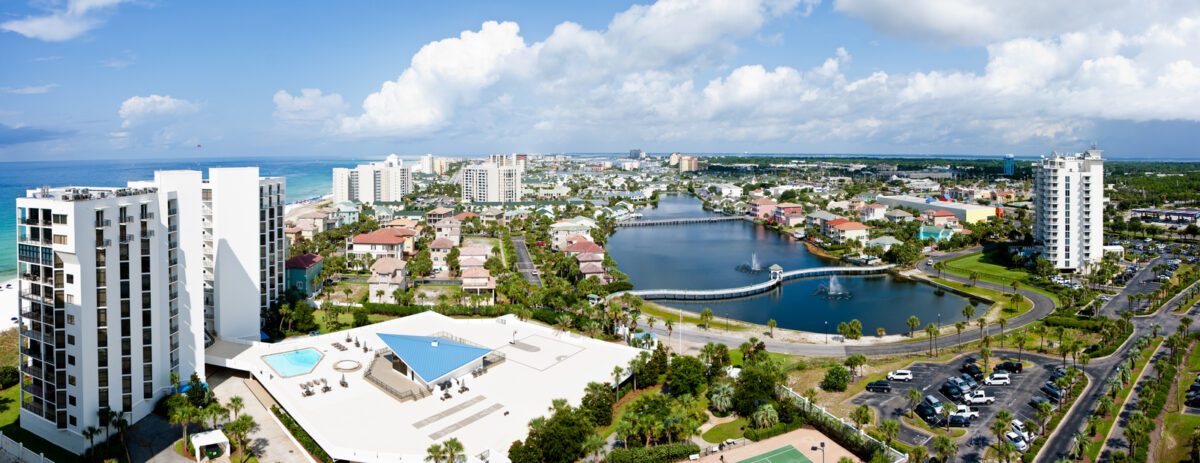Share the post "Moving To Texas Or Florida (Facts To Know)"
Deciding where to relocate is an important life decision. Although the cost of living, employment, and service availability matter, quality of life is a consequential deciding factor. Comparing Texas to Florida, there are many similar advantages. However, each state has pros and cons that must be considered.
Texas and Florida are appealing, but all things considered, Texas is a better relocation option than Florida. Texas has excellent employment opportunities, and the living costs are considerably less. Texans are friendly, and the state has rural, town, and city dwellings.

- Facts About Texas And Florida
- Economic Indicators In Texas And Florida
- Climate In Texas Compared To Florida
- Healthcare Systems Compared
- Education Facilities
- Transport Options
- Crime Rate and Safety
- Cultural and Recreational Activities
- Pros And Cons Of Living In Texas Vs. Florida
- FAQs About Texas Vs. Florida
Facts About Texas And Florida
Texas is in the South-Central region of the United States and is 2nd only to Alaska in area and population to California. In contrast, Florida borders the Atlantic Ocean and the Gulf of Mexico.
Comparatively, Texas encompasses large portions of rural areas and smaller towns with a far lower population density. Moving to Texas allows new residents to choose a large city dwelling or a low-key town environment.
| Texas | Florida | |
| Total Area in sq mi | 268,596 | 66,758 |
| Land in sq mi | 261,232 | 53,625 |
| Water in sq mi | 7,365 | 12,133 |
| Population Total | 29,145,505 | 22,244,823 |
| Area Rank U.S. | 2nd | 22nd |
| Population Ranking in the U.S. | 2nd | 3rd |
| Population Density in sq mi | 114 | 414.8 |
| Population Density Ranking U.S. | 26th | 8th |
| Median Household Income | $64,034 | 57,700 |
| Income Rank Ranking U.S. | 22nd | 34th |
| Official Languages | English 64.9% Spanish 28.8% Other 6.3% | English 67%, Spanish 21.2%, Other 11.5% |
| Highest Elevation | 8,751 | 100ft |
| Capital City | Austin | Tallahassee |
| Largest City | Houston | Jacksonville |
| Largest Metropolitan Area | Dallas-Fort Worth | Miami |
| Time Zone (Majority of State) | UTC-06:00 (Central)Summer (DST) UTC-05:00 (CDT) | UTC-05:00 (Eastern)Summer (DST) UTC-04:00 (EDT) |
| Eastern Border | Louisiana | Atlantic Ocean |
| Northern Border | Oklahoma | Georgia, Alabama |
| Western Border | New Mexico | Alabama |
| Southern Border | Mexican States of Chihuahua, Coahuila, Neuvo Leon, Tamaulpas | Gulf of Mexico |
| Coast Line | Gulf of Mexico to the South East | Gulf of Mexico, Atlantic Ocean |

Economic Indicators In Texas And Florida
Both states have robust economies that drive employment opportunities. With no personal tax in Texas or Florida, both states offer attractive relocation options. A downside of living in Texas is the high rate of property tax, which offsets the state’s lack of income from personal taxation.
What Are The Economic Benefits Of Texas Vs. Florida?
Although cotton, cattle, and timber were the key income drivers in Texas for many years, the discovery of oil in the region has driven an economic boom. Texas now houses 53 Fortune 500 companies, which position it as having the most in the United States.
The industry continues to boom in Texas, including technology, agriculture, energy, aerospace, and biomedical sciences. An impressive advantage of the economic development in the area rocketed Texas to the status of 2nd highest gross state product.
Unemployment rates in Texas are on the decline. As of November 2022, they were at 4%; by May 2022, compared to May 2021, Texas had created an additional 250,000 job opportunities. Creating employment remains a priority in Texas, and many businesses focus on further training and up-skilling their staff.
Florida also has a flourishing economy and has the 4th largest gross state production. The economy in Florida is primarily based on tourism; however, the state has experienced a considerable economic growth spurt with industry and construction, healthcare research, and aeronautical advancements.
Unemployment in Florida is lower than the national average and sits at 2%.

Cost of Living In Texas Vs. Florida
The cost of living in Texas is considerably lower than in Florida. However, annual household income trumps Texas. Texas is one of the least expensive states to live in, and compared to Florida, it is 8% cheaper. The only downside to living in Texas is the property tax and slightly higher utility costs.
House prices in Texas and Florida are lower than the average in the United States. Still, houses in Texas lag on average $45,000 below Texas, which makes renting or buying a home an excellent drawcard for living in Texas.
Interestingly, the property appreciation in Florida is at 29.67%, tracked from April 2021 to April 2022, compared to 24.58% in Texas.
| Category | Texas | Florida |
| Annual Cost of Living | $61,975 | $69,40 |
| Median Household Income | $64,034 | $57,700 |
| Income Rank Ranking U.S. | 22nd | 34th |
| Cost of Housing | $11,243 | $14,875 |
| Median House Price | $172,500 | $215,300 |
| Utilities | $4,472 | $4,181 |
| Groceries | $4,786 | $5,596 |
| Transportation | $5,222 | $5,551 |
| Health Care Cost | $5,169 | $5,343 |
| Property Tax | 1.80% | 0.89% |
Taxation
The tax structures in Texas and Florida have several key differences and similarities, primarily in areas like sales tax, property tax, and income tax. Understanding these can provide a clearer picture of the overall tax burden in each state.
Texas
- Sales Tax:
- Texas has a state sales tax rate of 6.25%.
- Localities can add their own sales taxes, making the total sales tax rate as high as 8.25%.
- Property Tax:
- Texas does not have a state property tax, but local governments levy property taxes.
- Property tax rates are relatively high compared to many other states.
- Income Tax:
- Texas is one of the few states in the U.S. that does not levy a state income tax.
- This can be a significant advantage for residents, especially those with higher incomes.
- Other Taxes:
- Texas imposes various other taxes, including franchise taxes, on businesses.
- There are also taxes on specific goods, such as gasoline and cigarettes.
Florida
- Sales Tax:
- Florida’s state sales tax rate is 6%.
- Local governments can add to this, but the total rate generally remains lower than in Texas.
- Property Tax:
- Like Texas, Florida relies on local governments for property taxes.
- Property tax rates are generally lower in Florida than in Texas.
- Income Tax:
- Florida also does not have a state income tax, making it attractive for high earners.
- This lack of state income tax applies to both individuals and corporations.
- Other Taxes:
- Florida levies various other forms of taxes, including tourism and hospitality-related taxes.
- Taxes on goods like gasoline and cigarettes are also present.
Comparison:
- No State Income Tax: Both states do not have a state income tax, which can significantly benefit residents.
- Sales Tax: Both states have a base state sales tax, but the total rate can vary depending on local additions.
- Property Tax: Property taxes tend to be higher in Texas compared to Florida, reflecting a fundamental difference in local tax structures.
- Tourism Taxes: Florida, a major tourist destination, has additional tourism-related taxes.
The overall tax burden in each state depends on various factors, including property values, consumption patterns, and income. While Texas and Florida offer the advantage of no state income tax, they differ in property and sales tax structures.
Texas generally has higher property taxes, while Florida might have higher costs associated with tourism-related activities. These differences can significantly impact the overall cost of living and should be considered when comparing the two states.

Climate In Texas Compared To Florida
Weather and climate are key factors when moving, particularly across states. Texas and Florida are known to be warm states, and both have high humidity levels, particularly in the coastal areas.
The vastness of Texas means that temperatures can vary considerably, particularly during the winter months. Some areas further north and in the Texas panhandle experience snow and cold winter conditions. This state offers newcomers a choice of weather and climate options.
The downside of living in Texas is the tornadoes that strike the region; the state ranks highest on the tornado scale, statistically 139 annually.
Average Rainfall
Texas
| City | Jan | Feb | Mar | Apr | May | Jun | Jul | Aug | Sep | Oct | Nov | Dec | Annual |
|---|---|---|---|---|---|---|---|---|---|---|---|---|---|
| Houston | 3.38 | 2.98 | 3.36 | 3.60 | 5.14 | 5.93 | 3.76 | 4.33 | 5.55 | 4.92 | 4.33 | 3.69 | 51.47 |
| Dallas | 2.13 | 2.59 | 3.49 | 3.07 | 4.92 | 4.11 | 2.17 | 1.91 | 2.42 | 4.11 | 2.57 | 2.57 | 36.56 |
| San Antonio | 1.66 | 1.76 | 1.89 | 2.60 | 4.72 | 4.29 | 2.74 | 2.35 | 3.07 | 3.86 | 2.28 | 1.91 | 32.93 |
| Austin | 2.22 | 2.02 | 2.76 | 2.09 | 4.44 | 3.81 | 1.97 | 2.35 | 2.99 | 3.97 | 2.68 | 2.44 | 33.74 |
Florida
| City | Jan | Feb | Mar | Apr | May | Jun | Jul | Aug | Sep | Oct | Nov | Dec | Annual |
|---|---|---|---|---|---|---|---|---|---|---|---|---|---|
| Miami | 1.62 | 2.25 | 3.00 | 3.14 | 5.34 | 8.89 | 6.50 | 8.88 | 9.86 | 6.33 | 3.27 | 2.04 | 61.12 |
| Orlando | 2.35 | 2.47 | 3.77 | 2.68 | 3.45 | 7.58 | 7.21 | 7.13 | 6.06 | 3.31 | 2.17 | 2.58 | 51.76 |
| Tampa | 2.23 | 2.81 | 3.03 | 2.03 | 2.10 | 6.68 | 8.04 | 7.77 | 6.30 | 2.26 | 1.55 | 2.47 | 45.27 |
| Jacksonville | 3.31 | 3.09 | 3.77 | 2.64 | 3.21 | 6.66 | 6.54 | 7.76 | 8.19 | 3.57 | 2.16 | 2.48 | 54.38 |
Key Observations:
- Rainfall Variability: Florida cities generally receive more rainfall than Texas cities yearly.
- Summer Rainfall: Texas and Florida experience a significant increase in rainfall during the summer months, with Florida cities showing exceptionally high totals in June, July, and August.
- Annual Rainfall: On average, cities in Florida have a higher annual rainfall than Texas cities.
Hurricanes have plagued Florida with devastating effects. Florida is the only state, barring Hawaii, with a tropical climate in areas closer to the coast. Its environment is generally regarded as subtropical in the rest of the state.
Comparing the climates of Texas and Florida involves examining various climatic factors such as temperature, precipitation, humidity, and seasonal variations. Here’s a table highlighting the critical climate aspects of each state:
| Factor | Texas Climate | Florida Climate |
|---|---|---|
| Temperature | – Varies widely. | – Generally warmer and more consistent year-round. |
| – Northern areas experience cooler winters. | – Subtropical to tropical climate. | |
| – Southern areas are warmer, similar to Florida. | – Mild winters and hot, humid summers. | |
| Precipitation | – Tornadoes in some areas, hurricanes along the coast. | – High rainfall, especially in summer months. |
| – Prone to droughts in certain areas. | – Regular afternoon thunderstorms in summer. | |
| Humidity | – Lower in the west, higher in the east. | – Generally high humidity, especially in summer. |
| Seasonal Changes | – More pronounced, with distinct seasons. | – Less variation, mild winters, and hot summers. |
| Extreme Weather | – Tornadoes in some areas, hurricanes along coast. | – Hurricanes and tropical storms are common. |
| – Variable extreme temperatures. | – Risk of flooding in low-lying areas. | |
| Overall Climate | – Ranges from arid in the west to humid subtropical in the east. | – Predominantly subtropical with a tropical climate in the south. |
Texas Climate:
- Diversity: Texas’s climate varies significantly from north to south and east to west. The northern regions can experience cold winters, while the southern part has a more humid and warmer climate.
- Extreme Weather: Parts of Texas are prone to severe weather, including tornadoes and hurricanes along the Gulf Coast.
Florida Climate:
- Consistency: Florida has a more consistent climate with warm temperatures year-round.
- Rainfall and Humidity: It experiences high humidity and significant rainfall, especially during summer.
Key Differences:
- Seasonal Variation: Texas experiences more pronounced seasonal changes compared to Florida.
- Temperature Extremes: Texas can have more extreme temperature variations, whereas Florida generally maintains a warmer, more stable climate.
This comparison shows that while both states experience warm climates, Texas offers a more varied climate across its vast geography. In contrast, Florida maintains a more consistent subtropical to tropical climate, particularly noted for its high humidity and rainfall patterns.
Monthly Temperatures
The average monthly temperatures in the main cities of Texas and Florida provide a clear view of the climate differences between these two states. Below is a table featuring average temperatures for select cities in Texas and Florida.
Texas
| City | Jan | Feb | Mar | Apr | May | Jun | Jul | Aug | Sep | Oct | Nov | Dec |
|---|---|---|---|---|---|---|---|---|---|---|---|---|
| Houston | 53°F | 57°F | 64°F | 70°F | 77°F | 83°F | 85°F | 85°F | 80°F | 72°F | 63°F | 55°F |
| Dallas | 47°F | 51°F | 58°F | 66°F | 74°F | 81°F | 85°F | 86°F | 79°F | 68°F | 57°F | 48°F |
| San Antonio | 52°F | 56°F | 63°F | 70°F | 77°F | 83°F | 85°F | 86°F | 81°F | 71°F | 61°F | 53°F |
| Austin | 51°F | 55°F | 62°F | 69°F | 76°F | 82°F | 85°F | 86°F | 80°F | 70°F | 60°F | 52°F |
Florida
| City | Jan | Feb | Mar | Apr | May | Jun | Jul | Aug | Sep | Oct | Nov | Dec |
|---|---|---|---|---|---|---|---|---|---|---|---|---|
| Miami | 68°F | 70°F | 73°F | 77°F | 81°F | 84°F | 85°F | 85°F | 83°F | 79°F | 74°F | 70°F |
| Orlando | 59°F | 61°F | 66°F | 71°F | 76°F | 81°F | 82°F | 82°F | 81°F | 75°F | 68°F | 62°F |
| Tampa | 62°F | 64°F | 68°F | 73°F | 78°F | 82°F | 83°F | 83°F | 82°F | 76°F | 69°F | 64°F |
| Jacksonville | 55°F | 57°F | 62°F | 67°F | 74°F | 80°F | 82°F | 82°F | 79°F | 72°F | 64°F | 57°F |
Key Observations:
- Winter Months: Texas cities generally have cooler temperatures in winter (Jan, Feb, Dec) compared to Florida cities.
- Summer Months: Both states experience warm to hot temperatures in summer, with Texas cities often reaching higher peaks in July and August.
- Variability: Texas shows more variability in temperature across the seasons compared to Florida, which maintains more consistent warmth year-round.
This comparison illustrates the climatic diversity in Texas, with cooler winters and hotter summers, whereas Florida maintains a more consistently warm climate throughout the year.

Healthcare Systems Compared
Comparing the quality and accessibility of healthcare services in Texas and Florida involves several factors, including the availability of hospitals, doctors, specialists, and healthcare insurance options. Here’s a comparative overview:
Texas Healthcare System
- Availability of Hospitals and Doctors
- Texas has many hospitals, with major medical centers in cities like Houston, Dallas, San Antonio, and Austin.
- Rural areas, however, may face challenges with fewer healthcare facilities and professionals.
- Specialists
- Texas boasts some nationally recognized specialties, particularly in cancer treatment (MD Anderson Cancer Center in Houston) and pediatric care.
- Healthcare Insurance Options
- Texas has a higher uninsured rate compared to the national average.
- The state did not expand Medicaid under the Affordable Care Act (ACA), limiting some low-income residents’ access to insurance.
- Quality of Care
- Quality can vary significantly. World-class healthcare is available in urban centers, but more remote areas may have limited access to high-quality care.
Florida Healthcare System
- Availability of Hospitals and Doctors
- Florida also has numerous hospitals, notably in cities like Miami, Tampa, and Orlando.
- The state has a significant elderly population, influencing the availability of senior and specialized healthcare services.
- Specialists
- Florida is known for excellent senior care and rehabilitation services, catering to its older population.
- Healthcare Insurance Options
- Florida also did not expand Medicaid but has diverse private insurance options.
- The state has a large Medicare population due to its elderly demographics.
- Quality of Care
- Similar to Texas, the quality of healthcare in Florida varies. Urban areas typically offer higher quality care than rural regions.
Comparative Analysis
- Rural vs. Urban Healthcare: Both states face the urban-rural divide, with better services in metropolitan areas.
- Insurance Coverage: Both have high rates of uninsured residents, partly due to not expanding Medicaid.
- Specialized Care: Texas is renowned for cancer care and pediatric services, while Florida excels in senior and rehabilitative care.
- Demographic Impact: Florida’s elderly population significantly influences its healthcare services, while Texas’s diverse demographics lead to varied healthcare needs.
Texas and Florida offer robust healthcare services, especially in urban centers, with specific specializations influenced by demographic trends. However, challenges remain in rural healthcare access and insurance coverage in both states.

Education Facilities
Both states have ample and diverse education facilities. However, the standard of education in Florida marginally surpasses that of Texas. Florida rates 27th in academic performance and ranks 25th overall. Texas, on the other hand, ranks 28th in both academic performance and overall ranking.
Although Florida rates just above Texas on education scores, school safety is a crucial consideration, particularly for parents. Texas ranks as providing the 11th safest school environment, whereas Florida trails at 24th.
Texas Education System
- Educational Policies and Standards
- Texas has its educational standards, the Texas Essential Knowledge and Skills (TEKS).
- The state strongly focuses on standardized testing, with the STAAR (State of Texas Assessments of Academic Readiness) program.
- Student Performance
- Texas students have shown mixed results in national assessments like the National Assessment of Educational Progress (NAEP).
- Performance varies significantly between urban and rural districts and among different socioeconomic groups.
- Funding
- Texas has faced criticism for its school funding system, which relies heavily on local property taxes, leading to district funding disparities.
- Innovation and Diversity
- Texas boasts a diverse student population, requiring educational approaches catering to various cultural and linguistic backgrounds.
- The state has many charter schools and is exploring innovative education models.
Florida Education System
- Educational Policies and Standards
- Florida follows the Common Core State Standards, with a strong emphasis on reading and math skills.
- Known for its comprehensive assessment system, including the Florida Standards Assessments (FSA).
- Student Performance
- Florida students generally perform well in national assessments and have shown improvements, especially in reading and math.
- The state is often recognized for its education reform and student achievement progress.
- Funding
- Similar to Texas, funding in Florida varies widely, with disparities based on locality.
- Florida has been active in using lottery funds to support education.
- Innovation and Diversity
- Florida is a leader in school choice, offering various options, including magnet schools, charter schools, and voucher programs.
- The state has a significant population of English language learners, influencing educational approaches.
Comparative Analysis
- Assessment and Accountability: Both states strongly focus on standardized testing and accountability.
- Funding Issues: Both face challenges in equitable funding across districts.
- Educational Choices: Florida is more aggressive in promoting school choice and charter schools, while Texas is gradually expanding in this area.
- Student Performance: While regional and demographic variations exist, Florida has made notable progress in student achievement, especially in early literacy.
In summary, Texas and Florida have robust educational systems that strongly focus on standardization and accountability. Florida has made significant strides in improving student performance.
It offers various educational choices, whereas Texas faces challenges in equitable funding and catering to a diverse student population. Both states continue to seek innovative solutions to improve their education systems.

Transport Options
Texas is a large state with vast distances to travel between cities. Interstate highways connect the cities, and having a car is advantageous. Conversely, Florida is smaller, but you need a car. Both states have local transport services and several airports.
| Texas | Florida | |
| Number of Major Airports | 24 | 131 |
| International Airports | 12 | 24 |
| Interstate Routes | 18 | 14 |
Texas Transportation System
- Road Network
- Extensive highway system, including numerous interstate highways and state routes.
- Texas has one of the largest networks of roads and highways in the U.S., reflecting its vast geographic size.
- Public Transportation
- Major cities like Houston, Dallas, Austin, and San Antonio have their public transit systems comprising buses and light rail.
- Public transportation is more developed in urban areas, but rural areas often lack comprehensive public transit options.
- Air Travel
- Home to major international airports like Dallas/Fort Worth International Airport and George Bush Intercontinental Airport in Houston.
- Several regional airports support intrastate and interstate travel.
- Freight and Rail Network
- The extensive freight rail system is crucial for the state’s large agricultural and industrial sectors.
- Passenger rail services are limited, with Amtrak providing the primary long-distance options.
- Ports and Waterways
- Major ports, such as the Port of Houston, play a key role in international trade.
- The Gulf Coast provides vital access for maritime transport.
Florida Transportation System
- Road Network
- Florida’s road network is extensive, focusing on connecting major cities and tourist destinations.
- Interstate highways like I-95 and I-75 are crucial for north-south travel.
- Public Transportation
- Urban areas like Miami, Orlando, and Tampa have public transit systems, primarily buses and some rail services.
- The state is developing more comprehensive public transit options, including expanding rail services.
- Air Travel
- Major international airports include Miami International Airport and Orlando International Airport, strongly focusing on travel to Latin America and the Caribbean.
- Numerous regional and municipal airports support domestic air travel.
- Freight and Rail Network
- Florida has a well-developed freight rail system that focuses on transporting agricultural products and goods related to tourism.
- Passenger rail is limited but includes services like Amtrak and the Brightline (a higher-speed rail system in South Florida).
- Ports and Waterways
- Florida’s location makes it a hub for cruise ships and international shipping, with major ports like PortMiami and Port Everglades.
- The state’s extensive coastline and inland waterways are also used for local transport and tourism.
Comparative Analysis
- Road Networks: Both states have extensive road networks, but Texas has a larger and more complex highway system due to its size.
- Public Transportation: Public transit is more developed in Texas’ major cities, while Florida is expanding its rail services and focusing on connecting tourist destinations.
- Air Travel: Both states have major international airports, but Florida strongly focuses on tourism-related air travel.
- Freight and Rail: Texas has a more extensive freight rail network, reflecting its larger industrial base.
- Ports and Waterways: Both states utilize their ports for international trade, but Florida has a more significant focus on cruise and tourism-related maritime activities.
In summary, while both Texas and Florida have developed transportation systems, their focus differs due to Texas’s larger size and industrial base and Florida’s emphasis on tourism and international travel. Both states are working to expand and modernize their transportation infrastructure to meet the needs of their growing populations and economies.

Crime Rate and Safety
When analyzing crime rates and safety in Texas and Florida, it is crucial to consider various aspects such as violent crime rates, property crime rates, and the overall safety of communities. Here’s a detailed analysis:
Texas
- Violent Crime Rates:
- Texas has a relatively high rate of violent crimes, including assault, robbery, and homicide.
- Larger cities like Houston and Dallas tend to have higher rates of violent crime compared to the national average.
- Property Crime Rates:
- Property crimes, including burglary, theft, and motor vehicle theft, are also a concern in many parts of Texas.
- Urban centers generally experience higher rates of property crime.
- Overall Community Safety:
- The perception of safety can vary significantly across Texas.
- Rural and suburban areas are often perceived as safer than larger cities.
- Community policing and crime prevention programs are active in many parts of the state.
Florida
- Violent Crime Rates:
- Similar to Texas, Florida has a higher-than-average rate of violent crimes.
- Cities like Miami, Orlando, and Jacksonville have notable rates of violent crimes.
- Property Crime Rates:
- Property crime rates in Florida vary, with some urban areas experiencing high rates.
- Tourist areas often have additional security measures that can impact crime rates.
- Overall Community Safety:
- Safety perception in Florida is higher in tourist-friendly and suburban areas.
- Urban areas, especially those not frequented by tourists, tend to have a lower perception of safety.
- Florida’s law enforcement agencies are proactive in implementing crime reduction strategies.
Comparison:
- Urban vs. Rural Areas: Both states exhibit a divide in crime rates between urban and rural areas. Larger cities in both Texas and Florida tend to have higher crime rates.
- Violent vs. Property Crimes: Both states face violent and property crimes, but the prevalence and severity can vary by location.
- Community Initiatives: Texas and Florida both have active community policing and crime prevention initiatives, though their effectiveness can vary by region.
Both Texas and Florida have areas with high crime rates, especially in urban centers. However, there are significant differences based on specific locations within each state. Overall, the perception of safety is often higher in suburban and rural areas compared to urban centers in both states.

Cultural and Recreational Activities
Comparing Texas and Florida’s cultural and recreational activities provides insight into each state’s diverse opportunities. Here’s an overview:
Texas
- Cultural Activities:
- Arts and Museums: Texas is home to renowned museums like the Houston Museum of Natural Science, the Dallas Museum of Art, and the San Antonio Museum of Art.
- Music Scene: Austin, the “Live Music Capital of the World,” hosts numerous music festivals like South by Southwest (SXSW) and Austin City Limits.
- Historical Sites: The Alamo in San Antonio, the Space Center in Houston, and the Fort Worth Stockyards offer a glimpse into Texas history.
- Recreational Activities:
- Outdoor Adventures: Big Bend National Park and the Hill Country offer hiking, camping, and river activities.
- Sports: Texas is big on sports, with major teams in football, basketball, baseball, and more.
- Rodeos and Fairs: The Houston Livestock Show and Rodeo and the State Fair of Texas in Dallas are major events.
Florida
- Cultural Activities:
- Arts and Museums: The Salvador Dalí Museum in St. Petersburg, the Orlando Museum of Art, and Miami’s Art Deco Historic District are highlighted.
- Music and Film Festivals: Miami hosts Ultra Music Festival, and the Florida Film Festival in Orlando is a significant event.
- Historical Sites: St. Augustine, the oldest city in the U.S., and the Kennedy Space Center offer rich historical experiences.
- Recreational Activities:
- Beaches and Water Sports: Florida’s extensive coastline offers beaches, snorkeling, and water sports.
- Theme Parks: World-famous theme parks in Orlando, including Walt Disney World and Universal Studios.
- Nature and Wildlife: The Everglades National Park offers unique wildlife and outdoor experiences.
Key Differences:
- Cultural Depth: Texas tends to focus more on historical and music-related cultural aspects, while Florida is more oriented toward visual arts and film.
- Recreational Diversity: Texas offers a blend of urban and rugged outdoor experiences, whereas Florida is renowned for its beaches and theme parks.
- Climate Influence: The activities in both states are shaped by their climates; Texas, with its diverse landscapes, offers varied outdoor activities, while Florida’s warm climate makes it a haven for beach and water-related recreation.
Both states boast rich cultural scenes and diverse recreational activities, but they cater to different preferences based on their unique historical backgrounds and geographical features.

Pros And Cons Of Living In Texas Vs. Florida
Both Texas and Florida are appealing states to move to. In addition to evaluating the demographics, climate, economy, and education standards, several other factors come into play when deciding whether to move to Texas or Florida.
Pros Of Living In Texas
- Culturally rich state, steeped in history with lots to see and do
- Option of living in towns or cities
- Well recognized for its food and gastronomic delights
- Over 100 parks, many with camping sites
- Significant arts community with theatres, resident orchestras, and ballet companies
- Family-friendly neighborhoods
- Fewer government regulations and less red tape
Cons Of Living In Texas
- Limited access to good healthcare
- Lengthy distance to travel across the state
- High crime in certain areas
- The area is home to many bugs, and due to the warm weather, residents often deal with mosquitoes, bees, wasps, and roaches.
Pros Of Living In Florida
- Active sports scene with many teams playing in the national leagues
- Amusement parks such as Disneyland, Universal Studios, Legoland, and Sea World
- Water recreation
- Locals have discounted rates for Florida’s top attractions.
Cons Of Living In Florida
- Low-ranked healthcare facilities
- The crime rate is above the national average
- Infestations of mosquitoes, termites, roaches, rats, and lizards
- The high influx of tourists can cause congestion on beaches and local attractions

FAQs About Texas Vs. Florida
Which State Is Best To Retire To, Texas Or Florida?
Both states are ideal for retirement. Warmer weather and no personal tax make Texas and Florida great choices. However, the cost of living in Florida may be prohibitive to retirees who do not earn a fixed income. Money stretches further in Texas.
Where Are The Best Employment Opportunities, Texas Or Florida?
Texas ranks 12th in the United States in the best place to find employment category, while Florida rates 20th.
Share the post "Moving To Texas Or Florida (Facts To Know)"
Christian Linden is a seasoned writer and contributor at Texas View, specializing in topics that resonate with the Texan community. With over a decade of experience in journalism, Christian brings a wealth of knowledge in local politics, culture, and lifestyle. He holds a Bachelor's degree in Communications from the University of Texas. When he's not writing, Christian enjoys spending weekends traveling across Texas with his family, exploring everything from bustling cities to serene landscapes.











